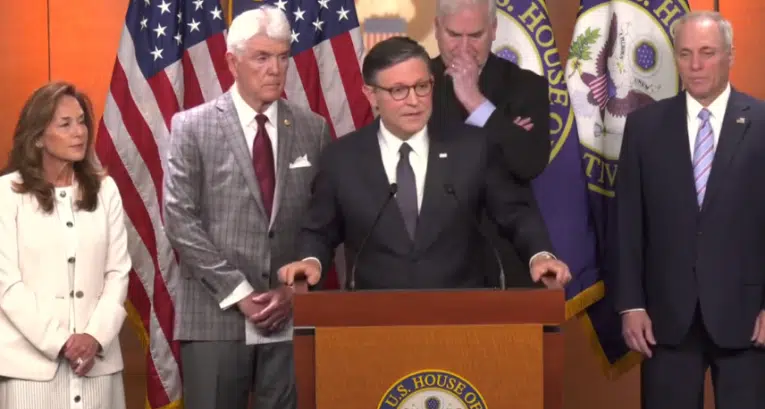 By Robert Romano – Now that the House of Representatives has passed the “Cut, Cap, and Balance Act,” it is up to the Senate to do its job. Harry Reid needs to pass something. It has become his problem.
By Robert Romano – Now that the House of Representatives has passed the “Cut, Cap, and Balance Act,” it is up to the Senate to do its job. Harry Reid needs to pass something. It has become his problem.
The House plan makes any increase in the $14.294 trillion debt ceiling contingent on $111 billion of immediate spending cuts, capping spending to a declining percent of the Gross Domestic Product (GDP), and there being a Balanced Budget Amendment sent to the states.
“Cut, Cap, and Balance” will save about $5.8 trillion over ten years. It is said the proposal has no chance in the Senate, but Republicans should fight for it nonetheless, and get an up-or-down vote on it.
At the end of the day, the Senate can reject any proposal it wants, but it is not enough to be against the House plan. Reid still needs to pass an alternative bill, else “Cut, Cap, and Balance” will remain the only proposal on the table that represents any form of a consensus on this issue.
Whatever the Senate passes should at a minimum be as large as the House plan in terms of real savings. That’s important, because whatever passes in the end must reduce the deficit by at least $4 trillion over ten years in order to avert a downgrade of the nation’s Triple-A credit rating by Moody’s, S&P, and Fitch.
Sadly, unless the Senate is about to vote on a marvelous plan from Senator Tom Coburn that saves $9 trillion over ten years, it will not be considering anything that comes anywhere near close to achieving the real savings needed to restore order to the nation’s fiscal house.
Originally, the Obama Administration wanted a “clean” vote increasing the debt ceiling without any deficit reduction. The American people should be thanking House Republicans for rejecting that approach, as apparently it would have resulted in a credit downgrade, higher interest rates, and probably a catastrophic default down the road.
Another plan proposed by Senate Minority Leader Mitch McConnell would raise the debt ceiling in exchange for the White House submitting a piece of paper suggesting offsetting spending cuts. The problem is that it would not require any actual spending cuts or deficit reduction being implemented.
In fact, for the credit rating agencies, the McConnell plan is a non-starter in terms of affirming the nation’s creditworthiness. Moody’s analyst Steven Hess has already said that the plan might result in a “negative” rating, making a full downgrade of the Triple-A rating substantially more likely over the next 12 to 18 months.
Said Hess, “the numbers that are being discussed in terms of any possible deficit reduction coming out of this plan don’t seem to be very large.” That’s because the McConnell plan does not actually contain any spending cuts, and only vaguely promises $1.5 trillion in savings. It therefore does not save the minimum obligatory $4 trillion, failing to avert a downgrade.
The Senate should not even waste its time.
The whole point of the McConnell plan was to take the debt ceiling issue off the table and solve a political problem for Republicans concerned about being blamed for a default. It never was intended to be a serious proposal that might avert a credit downgrade or a long-term default by the Treasury.
That leaves the Senate with the so-called “Gang of Six” proposal, which supposedly would save $3.7 trillion over the next ten years. Of course, the devil’s in the details, but it must be said that even if true, it would still be $300 billion shy of Moody’s $4 trillion minimum savings mark. $300 billion is not an insignificant number — it’s actually 2 percent of the entire economy.
So, this would not prevent a downgrade either. It might only delay the inevitable. But, worse than that, $1 trillion of the alleged savings is supposed to result from revenue being higher than even the current government baseline.
To put into perspective just how rosy that is, the Office of Management and Budget’s baseline scenario already has revenues rising from $2.174 trillion this year to $4.820 trillion in 2021. An extra $1 trillion in revenue over ten years would mean an extra $100 billion a year, yielding $4.920 trillion in revenue in 2021.
So for the savings under this proposal to be realized, revenues will have to grow by 126 percent in the next ten years, and the economy will have to practically double in size. That’s insane. The baseline’s economic assumptions were already unbelievably optimistic to begin with. It assumed a robust economic recovery that is simply nowhere to be found as unemployment remains over 9 percent and growth very weak.
Assuming the baseline assumptions are wrong, and revenues will only rise to, say, $3.5 trillion by 2021, the debt will actually increase by more than $7 trillion above the baseline. That will destroy any savings under the “Gang of Six” proposal.
To be fair, that’s the same problem that every proposal faces. Should the economy continue to flounder, that means spending will have to be cut by far larger margins than is currently even being contemplated.
“Cut, Cap, and Balance” addresses this very real possibility because those spending cuts would be required as a matter of law to meet the spending caps and to balance the budget under the proposal.
The deficiencies of the “Gang of Six” proposal do not end there. It defers much of its non-specific savings to House and Senate committees, and therefore does not guarantee any actual spending cuts. That’s because the “Gang of Six” proposal is largely non-binding, having no more effect at reducing the deficit than a speech or a commission.
It would still require additional votes in both houses of Congress and Barack Obama’s signature to achieve the savings — if they’re even real. So, the “Gang of Six” plan will not actually save $3.7 trillion over ten years, and will not in principle avert a credit downgrade either.
That makes “Cut, Cap, and Balance” the only serious proposal out there that has passed either chamber of Congress.
And it means the Senate is out of excuses. Harry Reid needs to pass something. But it can’t be just anything. To avert a downgrade, Reid either needs to come up with a big plan of his own saving $4 trillion over ten years, pass the Coburn $9 trillion plan, or pass the “Cut, Cap, and Balance” proposal.
Robert Romano is the Senior Editor of Americans for Limited Government.





